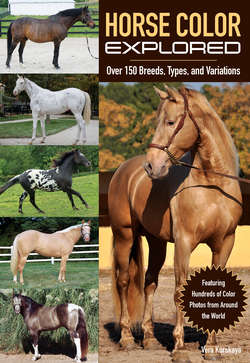Читать книгу Horse Economics - Vera Kurskaya - Страница 22
На сайте Литреса книга снята с продажи.
CHESTNUT
ОглавлениеChestnut color is a relatively uniform red or brown color of the trunk, legs, mane, and tail (Photos 10 & 11). Shades can range from very light red, to close to apricot, to dark, to almost black (dark red and dark brown). The mane and tail in chestnut horses are usually of the same color as the body, but it is not unusual to see horses with brighter or darker guard hair. The skin and hooves are pigmented, the eyelashes red, eyes hazel.
Dark (liver) chestnut horses have dark orange or brown color of body hair. The mane and tail can be the same tone as the body or brighter (yellowish or even flaxen), or sometimes darker. Standard (average) chestnut horses are orange or red-colored. Guard hair can be the same tone as the body hair, or lighter or darker. Light chestnut horses have light carrot or almost yellow color of the body hair. This nuance is characteristic for the Akhal-Teke and Russian Don horses, and also for many draft breeds. The mane and tail are typically brighter than the body hair.
Chestnut horses with a whitish or almost white hair in the mane and tail are called flaxen chestnuts (Photos 12 & 13). The mane and tail usually change shade with seasons and can become lighter or darker, depending on the individual animal. I discuss flaxen chestnuts and specific information about heredity in more detail on p. 39.
It is extremely rare to encounter chestnut horses with brown, dark brown, or black color of the mane and tail, and it may be indicative of false red dun (see p. 26 and photos 14 & 15). This version of chestnut color is characteristic of the Karabakh, Russian Don, and Budyonny breeds. In addition, many Russian Don and Budyonny horses develop a golden gloss to their hair.
The darkest version of chestnut color is called liver chestnut (Photo 16). The mane and tail can be yellowish, the same shade as the horse’s torso, or almost black. This color can be distinguished from dark bay by the body and legs—they are black in a bay (see p. 14). There is also a very rare shade of dark liver chestnut color, which can be confused with black. In this case the tail and mane can range from white, to vivid red, to the same color as the horse’s trunk. This color can be found in Morgan horses, for example. Such horses can be identified as chestnut with the aid of DNA analysis.
The hair of chestnut horses can also fade; in such cases, a horse may look like he is covered with dust.
Chestnut foals are born red color with whitish legs and underbelly. Guard hair is often light. The foals become darker with age.
Chestnut color is common, surpassed in frequency only by bay. It is prevalent in the Arabian, Thoroughbred, Hanoverian, Budyonny, and Karabakh breeds, and some breeds have a characteristic chestnut shade, including Suffolk Punch and Russian Don horses. Chestnut color is encountered extremely rarely in Friesians, Percherons, Cleveland Bay, Orlov Trotters, Exmoor ponies, and Andalusians.
